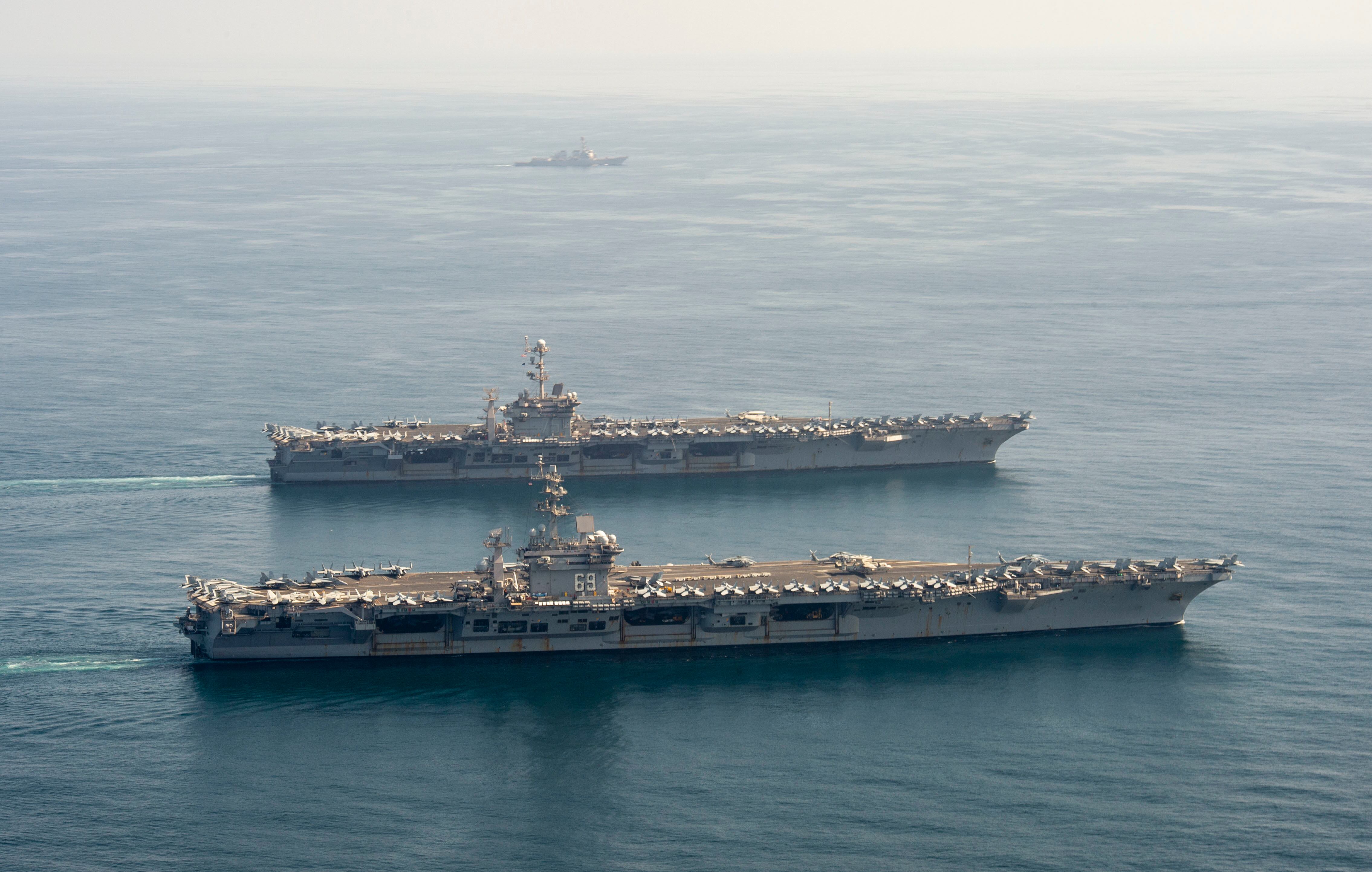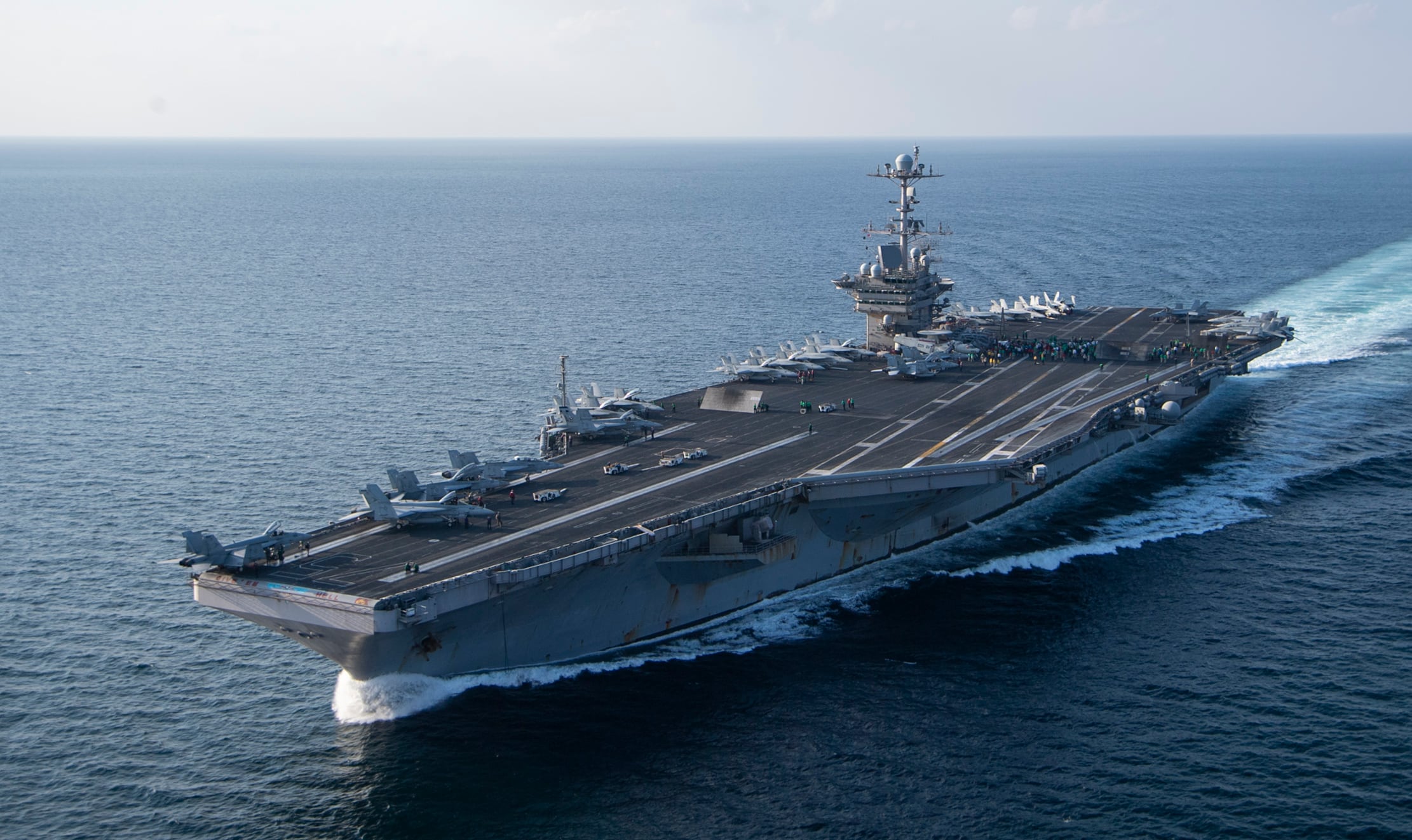WASHINGTON — By the time the crews of the aircraft carrier Nimitz and its escort ships step on the pier in Bremerton, Washington, they will have been away from home for almost a year, most of which will have been spent floating around in the Middle East.
Until the last decade, the U.S. Navy tried to limit deployments to six months to give crew members ample time for training and maintenance. But as the fleet contracted and demands remained steady — or occasionally grew — the length of Navy deployments exploded to as many as 10 months or more, forcing the fleet to fall back on extreme measures such as sending carriers out twice in the same 36-month deployment cycle, colloquially known as a “double-pump” deployment.
After showing signs of improvement following two deadly collisions in 2017, the Navy is again under pressure to provide aircraft carrier presence to the Middle East for the American regional force, U.S. Central Command, despite what experts say is limited public evidence that such deployments deter the United States’ top geopolitical adversary in the region: Iran.
Setting priorities
The Navy has called its current pace of operations unsustainable. Historically, long deployments with aging carriers create expensive logjams in public and private shipyards, where workers rush to fix equipment that was used in excess of what it was designed for. Delays at shipyards mean longer deployments for the ships used for forward presence.
The Biden administration has begun a global force posture review, like the Trump team, which also tried to pivot from heavy naval presence in the Middle East as a means of preserving forces for potential conflict in Europe or Asia. With experts and lawmakers alike intent on considering competition with China, might the new administration finally break the cycle of deploying the fleet beyond its means to service Central Command’s demands?
There’s reason to believe that may be the case.
In his confirmation hearing last month, Defense Secretary Lloyd Austin told senators that while he had spent most of his career thinking about the Middle East, his arrival at the Pentagon would bring with it a focus on China. Austin, a retired Army general, led CENTCOM from 2013 to 2016.
“I was focused on the Middle East for quite some time because that was the most important thing for our country,” he said. “So we put our best equipment towards that effort, our best people, and it was absolutely necessary at the time.
“But if confirmed, you can expect that I’ll put a laser-like focus on developing the right capabilities, plans and operational concepts that’ll ensure that we maintain a competitive edge as we look at ourselves with respect to China.”
Austin also told lawmakers that “Asia must be the focus of our effort, and I see China in particular as a pacing challenge for the department.”
It’s not the first time a defense secretary called for a refocus of the Defense Department’s efforts toward China. But Central Command’s siren song continues to draw aircraft carriers back to the Middle East.
During testimony in March 2020, Central Command chief Gen. Kenneth McKenzie told House lawmakers that the aircraft carrier “has a profound deterring effect, principally upon Iran.”
“They know what the carrier is. They track the presence of the carrier. And I view a carrier as a critical part of a deterrent posture effective against Iran,” he said.
RELATED

But some experts and analysts openly dismiss McKenzie’s logic, noting that there is little evidence Iran was deterred by carriers.
Emma Ashford, a senior fellow at the Atlantic Council who focuses on Middle East issues, said there is limited benefit in keeping the carrier in the region.
“I do not believe a carrier presence is necessary for stability in the Middle East,” Ashford said. “The actual strategic benefits of the carrier are relatively small, as we can use land bases to accomplish most of the same objectives should the need arise.
“And the ‘deterrent’ effects of the carrier are massively overstated. There’s little evidence that a carrier would be useful against attempts to, say, close the Strait of Hormuz, and it certainly doesn’t deter Iran from using proxy forces in the region.”
Indeed, the presence of the Truman Carrier Strike Group in the Arabian Sea in January 2020 did not deter Iran from launching a ballistic missile strike on U.S. troops in Iraq in retaliation for the assassination of one of its top generals, even though the group would most certainly have been in a position to unleash punishing strikes if President Donald Trump had chosen that course.
Partly, as Ashford noted, this is because Iran’s primary methods of projecting power in the region aren’t threats that can easily be bombed from carriers.
“It’s an asinine strategy,” Bryan Clark, a former senior aide to the chief of naval operations and now a senior fellow at the Hudson Institute, told Defense News last year. “The Iranians don’t perceive carriers as a threat to their ability to project power because they project power through gray zone activities and terrorism — the kinds of things that carriers aren’t very good at dealing with.”
Supply-based deployments
Senior Navy leadership has tried for years to move the service away from accommodating combatant commander’s demands, and toward a system that provides the most forces possible that can also be properly maintained, manned, trained and equipped. This was the intention behind the Navy’s Optimized Fleet Response Plan when it first rolled out in 2014: Create the maximum availability for aircraft carrier presence while preserving enough time in the schedule for maintenance and a proper pre-deployment training regime.
The U.S. has 11 carriers, but no more than eight are available for tasking at any given time. The Gerald R. Ford is not yet certified for tasking, one carrier is always in its midlife complex overhaul and refueling, and at least one other carrier is in an extended maintenance period.
So among the eight remaining carriers, the fleet is generally charged with providing a carrier for the Middle East and a carrier for the Asia-Pacific region.
The Asia-Pacific region is covered for six months every year by the forward-deployed carrier Ronald Reagan out of Japan, but U.S.-based ships must make up the other half. And if the Pentagon doesn’t want to leave the Pacific uncovered for large swathes of the year while also covering the Middle East, the Navy must maintain the deployment of two to three U.S.-based carriers year-round — an immense burden on a de facto fleet of eight aircraft carriers.
RELATED

But if combatant commanders want more than two to three carriers deployed, and if those requests are approved by the defense secretary, the Navy would have to perform scheduling backflips that eat away at its deployment cycle schedule. Endemic maintenance delays for carriers, surface ships and attack submarines also eat into the schedule, making time a scarce resource for the fleet.
Furthermore, deploying the fleet significantly longer than the traditional six-month deployment creates more maintenance problems as parts break or need replaced — something that also eats into the schedule.
In January, Chief of Naval Operations Adm. Mike Gilday said that if the Navy is to effectively modernize for the future force while maintaining current presence missions, the service must be used as a supply-based service rather than meeting “an insatiable demand signal.”
Without specifically mentioning a region, Gilday told reporters that combatant commanders must make do with the force the service is able to adequately man, train and equip.
“If you look at the Navy, on any given day I got about a third of the fleet at sea,” he said. “And so here’s the way I present that as a service chief to the secretary of defense and the chairman [of the Joint Chiefs of Staff]: I say, ‘Look, the Navy’s got 100 players on the field today. How you want to use those 100 players, you have to decide.’
“This is where it comes back to a [National Defense Strategy] that’s really driving the department to be priorities-driven and supply-based. Because if you don’t, then … rebuilding readiness? You can never get there, you’re in this rut.”
‘Unrealistic’
The hard truth of the matter is that the Navy has little control over how its forces are used; it merely provides ready forces, Gilday explained.
“[The combatant commanders] are controlling those assets, and it’s the secretary that has to control how those assets are apportioned across those COCOMs [combatant commands] to be used,” the chief said. “Depending on how the priorities shift from day to day, Iran is probably the most likely threat and China is the most dangerous.”
Clark, of the Hudson Institute, said in a February interview that moving to a supply-based model is essential a way for the Navy to find a sustainable pace.

“You’ve got to look at a supply-based model of what the current force can deliver over time, and then that’s what’s available through the global force management process,” Clark said, referencing the Pentagon’s process of reviewing combatant commanders’ requests for forces. “And then you have the COCOMs actually start doing some strategy.”
“The other thing is figure out what are some alternative ways to provide capabilities in theater,” he added. “The Navy sort of created this problem for itself by arguing that the carrier strike group is the main unit of issue of naval forces. You condition the COCOMs to say, ‘I want a carrier in CENTCOM, I need a carrier,’ when an amphibious ready group may actually be a more appropriate force package — especially in Central Command.”
The Navy has found ways to catch its breath in the recent past. In September 2018, USNI News reported that the service was at a 25-year low for carrier deployments as the force tried to reset from years of burnout and overuse. In recent years, the Navy has left the Middle East bereft of a carrier for months at a time.
But to Bryan McGrath, a former destroyer skipper who now works as a defense consultant with The FerryBridge Group, moving to a solely supply-based model is unlikely to work. “Either a supply- or a demand-based force is equally unrealistic,” he said. “A supply-based force is unrealistic because it ignores the predilections of presidents and combatant commanders to wish to have forces available to prevent conflict to assure allies and to win wars. And a demand-based force is unrealistic because it is unaffordable. Because if you added up all the demands, you wind up with an 800-ship Navy.
“Realism is some sort of a hybrid between supply and demand. And a recognition that there will be times when the national command authority makes requests of the Navy that drive it into a sine wave of readiness. We must do our very best to be able to ascertain, one, what readiness means and, two, what getting back to readiness means when we have hit one of those readiness troughs.”
David B. Larter was the naval warfare reporter for Defense News.








